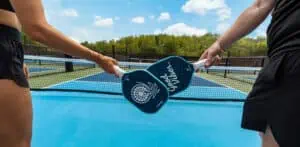Pickleball
Pickleball vs. Tennis: Key Differences Every Player Should Know

When it comes to racquet sports, two names often come up: pickleball and tennis. At first glance, they might seem quite similar, but dig a little deeper, and you’ll discover some key differences that set them apart. Have you ever wondered why one sport is gaining popularity, especially among older adults, while the other has longstanding roots in competitive play? This guide explores the unique features of each game, from court sizes to equipment and scoring systems. Whether you’re a newcomer to the court or just curious about these sports, understanding what makes pickleball and tennis tick can help you figure out which one might be your new favorite pastime. Let’s dive in!
The key differences between pickleball and tennis include court size, with pickleball courts being smaller at 44 feet long and 20 feet wide for doubles, compared to tennis courts, which are 78 feet long and 36 feet wide. Additionally, while tennis uses larger rackets and felt-covered balls, pickleball utilizes paddles made of wood or composite materials and plastic balls with holes, making it accessible for players of various skill levels.
Pickleball vs. Tennis: Comparing Game Basics
At the core of both pickleball and tennis lies a set of rules that defines how each sport is played, offering unique experiences for athletes. The most noticeable difference may be the court size:
- Pickleball courts measure 20 feet wide by 44 feet long for doubles.
- Tennis courts stretch to 36 feet wide by 78 feet long.
This smaller play area influences not only the pace of the game but also the strategies players employ—pickleball tends to favor quick reflexes and close-quarters rallies compared to the longer movements required in tennis.
With these varying dimensions, another facet comes into play—the net height. The net in pickleball is set at 36 inches high at the sidelines and dips to 34 inches in the center, whereas tennis nets are taller at 42 inches at the posts and 36 inches centrally. This variance allows for different types of shots; in pickleball, players can use more strategic volleying due to the lower net, while tennis often requires a greater emphasis on powerful overhand serves and baseline plays.
But beyond the physical setup of the games, it’s key to examine how equipment shapes player performance.
The equipment in each sport adds layers to gameplay. While tennis players wield larger stringed rackets designed for power and spin, pickleball players utilize solid paddles made from wood or composite materials. This fundamental difference in equipment affects playing styles significantly.
Pickleball paddles impart more control than traditional tennis racquets, making it easier for beginners who might find a full-sized racket cumbersome. The balls used further distinguish these sports; pickleball’s plastic balls feature holes that allow for less bounce and more unpredictable flight patterns, creating a unique challenge.
Scoring Systems
Scoring systems are yet another area of contrast between these two games. Tennis employs a traditional scoring system with terms like “deuce” and “advantage,” which can be somewhat complex for new players trying to keep track of games and sets.
In contrast, pickleball simplifies scoring with a straightforward format: games are usually played to 11 points and you must win by a margin of 2 points. This makes it easier for newcomers to grasp the game quickly and jump into play without feeling overwhelmed.
Both sports can be played as singles or doubles, but let’s highlight distinctive trends in player preferences and activity levels.
As both sports can be played with various team configurations, it’s worth noting that pickleball is especially favored for its doubles format. The smaller court means players can collaborate closely, making it an excellent social activity where teamwork shines through fun exchanges rather than sheer physical endurance.
In contrast, although tennis also enjoys participation across singles and doubles formats, many players appreciate the one-on-one challenge that singles matches provide—a test of pure skill and stamina across a larger expanse.
While both sports share similarities as racquet activities, their respective structures create distinct atmospheres that attract different kinds of athletes. Understanding these differences lays a solid foundation for exploring crucial aspects like spatial dimensions and court arrangements that define each game.
Court Dimensions and Setup
The dimensions of a tennis court and a pickleball court are one of the primary ways these two sports diverge, shaping not only gameplay but also player strategy.
As mentioned earlier, a tennis court measures 78 feet long by 36 feet wide for doubles play, allowing players plenty of room to run, chase down balls, and engage in lengthy rallies that can last for several strokes. This spacious environment encourages a blend of speed and endurance, making it ideal for those who relish continuous movement.
In contrast, the pickleball court is significantly smaller at just 44 feet long by 20 feet wide for doubles, providing a starkly different experience. Its reduced size fosters quick reflexes and strategic shot placement, giving players fewer opportunities for expansive running. Instead, the game emphasizes paddle skills and swift decision-making over sheer athleticism, allowing players to focus on precision rather than merely covering distance.
Such differences in court size not only lead to variations in physical demands but also determine how players perceive the game itself.
Beyond dimensions, there are also implications regarding net height. In pickleball, the net is set at 36 inches high at the sidelines and 34 inches at the center, while tennis nets sit taller at 42 inches on the sides and lower to 36 inches in the middle. This alteration contributes to differences in volleying techniques across both sports; in pickleball, strikes often occur from a lower vantage point as players avoid hitting directly above their waist—an essential rule in this game.
- Length: 78 feet x Width: 36 feet (doubles)
- Length: 44 feet x Width: 20 feet (doubles)
With these specifications supporting each sport’s unique characteristics, choosing which game might best cater to your preferences can greatly enhance enjoyment.
For younger or less mobile players, pickleball’s smaller space offers accessibility without sacrificing fun. Meanwhile, athletes drawn to endurance may prefer the open environment of tennis.
As you step onto either court for a match or practice session, it’s vital to remember these spatial nuances that distinguish them. Embracing their unique setups can help you maximize your performance while enjoying every moment spent honing your skills.
This understanding paves the way for a deeper exploration of how equipment varies between the two games and what that means for gameplay dynamics.
Equipment: Paddle vs. Racquet
When it comes to equipment, the differences between a pickleball paddle and a tennis racquet are notable and can significantly affect gameplay.
Tennis racquets have strings that are typically made from materials such as nylon or polyester, providing a unique way to impart spin on the ball. This characteristic allows experienced tennis players to manipulate the trajectory of their shots effectively.
In contrast, pickleball paddles are solid, crafted from materials like wood, composite, or carbon fiber. These paddles do not have strings; instead, they rely on their smooth surfaces to create spin and control.
The weight of these tools also plays a critical role. Tennis racquets usually weigh between 9 and 12 ounces, making them a bit heftier than their pickleball counterparts, which typically weigh around 6-8 ounces.
This difference in weight contributes to the feel and style of play. A heavier racquet may offer more power but requires greater strength and precision for effective use, whereas the lighter paddle makes quick reflexes easier, ideal for those intense rallies common in pickleball.
But it’s not just about weight; grip size is another essential factor that influences player comfort and performance.
Grip sizes for pickleball paddles generally range from 4 to 4.5 inches, while tennis racquets feature grip sizes varying from 4 to 4 5/8 inches. Finding the right grip size is crucial because it affects how comfortably players can hold their equipment during play.
A too-big grip can lead to slippage and fatigue, while a too-small grip can make it difficult to stabilize the racquet or paddle during swings.
When trying out either sport, players should ensure they select equipment that feels natural in their hands. Whether you’re opting for a lightweight paddle in pickleball or a sturdy racquet for tennis, proper adherence to these specifications ultimately enhances overall performance and enjoyment of the game.
With this understanding of equipment differences now clear, we can shift our focus to the various aspects of gameplay—how to serve effectively, sustain rallies, and score points efficiently.
Serving, Rallying, and Scoring
Serving is more than just a way to start a match; it can set the rhythm of play in both pickleball and tennis. As noted, tennis serves are overhand and require a significant amount of strength and precision as players serve from behind the baseline. A well-placed tennis serve can dictate the tempo of the game, allowing players to capitalize on their opponent’s weaknesses right off the bat.
On the other hand, pickleball’s underhand serves are designed for accessibility, especially for beginners. The requirement to strike the ball below the waist makes these serves less intimidating, encouraging participation from players of varying skill levels.
Once the game is underway, how rallies function plays a pivotal role in each sport’s dynamic.
In pickleball, rallies are influenced by what’s known as the ‘kitchen’ or non-volley zone, which extends 7 feet from each side of the net. This unique feature prohibits players from volleying within this area, promoting longer and more strategic rallies. Players must let the ball bounce once before they can engage in volleys when returning shots from their opponents. This rule enhances gameplay by encouraging tactical play and maneuvering around the court, fostering patience and strategy.
In contrast, tennis allows for volleys at any point on the court without such restrictions. Players can hit the ball in midair after it bounces once or even before it touches the ground if they’re skilled enough. This creates sharper exchanges and dynamic plays that make matches feel quicker-paced with a flurry of movement.
With different serving styles and rallying rules established, one cannot overlook the significant variations in scoring systems between these two sports.
The scoring in tennis follows a traditional format that many might find intricate with its points system—15, 30, 40, and game. Each player only earns points while serving until they fail to win a point or commit a fault. These nuanced rules contribute to potentially longer matches filled with tension, as every point bears hefty weight on players’ strategies.
Conversely, pickleball employs a straightforward scoring system known as rally scoring, where points can be accrued by either team regardless of whether they are serving or receiving. Games typically go to 11 points (and must be won by at least two). This design simplifies gameplay and keeps excitement levels high because every rally could result in an immediate change in score irrespective of who started it.
Understanding these subtle yet important distinctions allows players to better adapt their strategies relevant to their chosen sport while enriching their overall playing experience.
As we look deeper into these games’ aspects, speed dynamics and physical intensity further illuminate how each sport engages its players.
Speed and Intensity
When it comes to speed, tennis takes the crown with its rapid-fire exchanges and high-stakes serves. Imagine a professional player launching serves at an astounding speed of 120 mph—a force that can catch opponents off guard! The expansive dimensions of a standard tennis court allow for exhilarating rallies but also demand quick footwork and agility. As players dart from one side of the court to the other, the significant increase in distance can lead to breathless moments as they engage in fast-paced duels.
Statistics reveal more than just impressive speeds; according to the U.S. Open, an average point lasts only about 5.7 seconds during professional matches. This short duration contributes to an electrifying atmosphere filled with drama and intensity.
On the flip side, pickleball offers a different flavor of competition. While it might not have the blistering speeds of tennis, the pace remains engaging in its own right. With smaller court dimensions that measure 44 feet by 20 feet for doubles play, players are often involved in lengthier rallies. The slower, whiffle-like ball used in pickleball encourages strategic shots rather than explosive serves, emphasizing positioning and skill over sheer speed. Players typically find themselves engaged in exchanges lasting around 3-5 shots per rally, which can stretch out to build anticipation without losing momentum.
In pickleball, it’s not just about power or quickness; it’s also about clever shot placement and tactical maneuvers that can turn the tide of a game.
Additionally, the physical demands of each sport shape who might gravitate towards them. Tennis often attracts those who revel in high-intensity settings where speed reigns supreme. The rigorous pace requires a heightened level of cardiovascular fitness and explosive strength. Conversely, pickleball’s intentional pacing makes it inviting for all ages and skill levels, fostering longer rallies that enhance social interaction within the game itself.
By understanding these differences in speed and intensity, players can better navigate their options and gain insight into their personal abilities as they consider what to pursue next.
Choosing the Right Sport for You
Pickleball is rapidly gaining traction across various demographics, particularly among seniors and individuals seeking a less physically demanding activity.
Its accessible nature means players can engage in friendly competition without the same intensity inherent in tennis.
If you’re someone craving high-energy workouts filled with quick sprints and strategic positioning, tennis might be your ideal choice.
The factor of cardio in tennis can be exhilarating; intense rallies keep your heart pumping and your body agile.
Conversely, if you find yourself more interested in social interaction or a game where strategy takes precedence over purely physical play, pickleball might fit your lifestyle better.
Pickleball encourages longer rallies thanks to its unique rules, such as the two-bounce rule and kitchen area, allowing players to enjoy tactical gameplay.
But how can you decide?
Begin by considering your fitness goals and any physical limitations. Assess what you enjoy most about sports: Is it camaraderie or the thrill of competition? Do you prefer a fast-paced environment or something more relaxed? Your answers can guide your decision.
For beginners, trying out both sports through community centers or local clubs is invaluable.
This way, you can experience firsthand what suits you best—after all, picking up a paddle or racket is just the first step towards enriching your life through either sport.
No matter which sport resonates with you more, don’t forget to check out our Pickleball Getaways on VibeGetaways.
We offer opportunities for immersive experiences, complete with world-class facilities and expert coaching tailored to your chosen sport, ensuring you make the most of your athletic journey. Contact us today or call us at 262-891-4768.
More Articles
Ultimate Checklist for Group Getaway Success – Your Complete Preparation Guide
Planning a group getaway can feel like juggling a dozen different balls at once—from sorting out where to go and…
Read MoreHow Travel Agency Service Saves You Time & Money: Top Benefits for Vacation Planning
Planning a vacation can feel exciting but also overwhelming; there’s so much to decide, from flights and hotels to activities…
Read MorePickleball Tournaments: Formats, Rankings & Complete Guide to Rules and Types
Pickleball has exploded in popularity, and with that growth comes a whole world of tournaments where players of all levels…
Read MoreSenior Pickleball Strategies: Mastering Pace, Placement, and Patience for Better Play
Pickleball is quickly becoming a favorite sport for seniors, offering a fun way to stay active and social without overtaxing…
Read More


